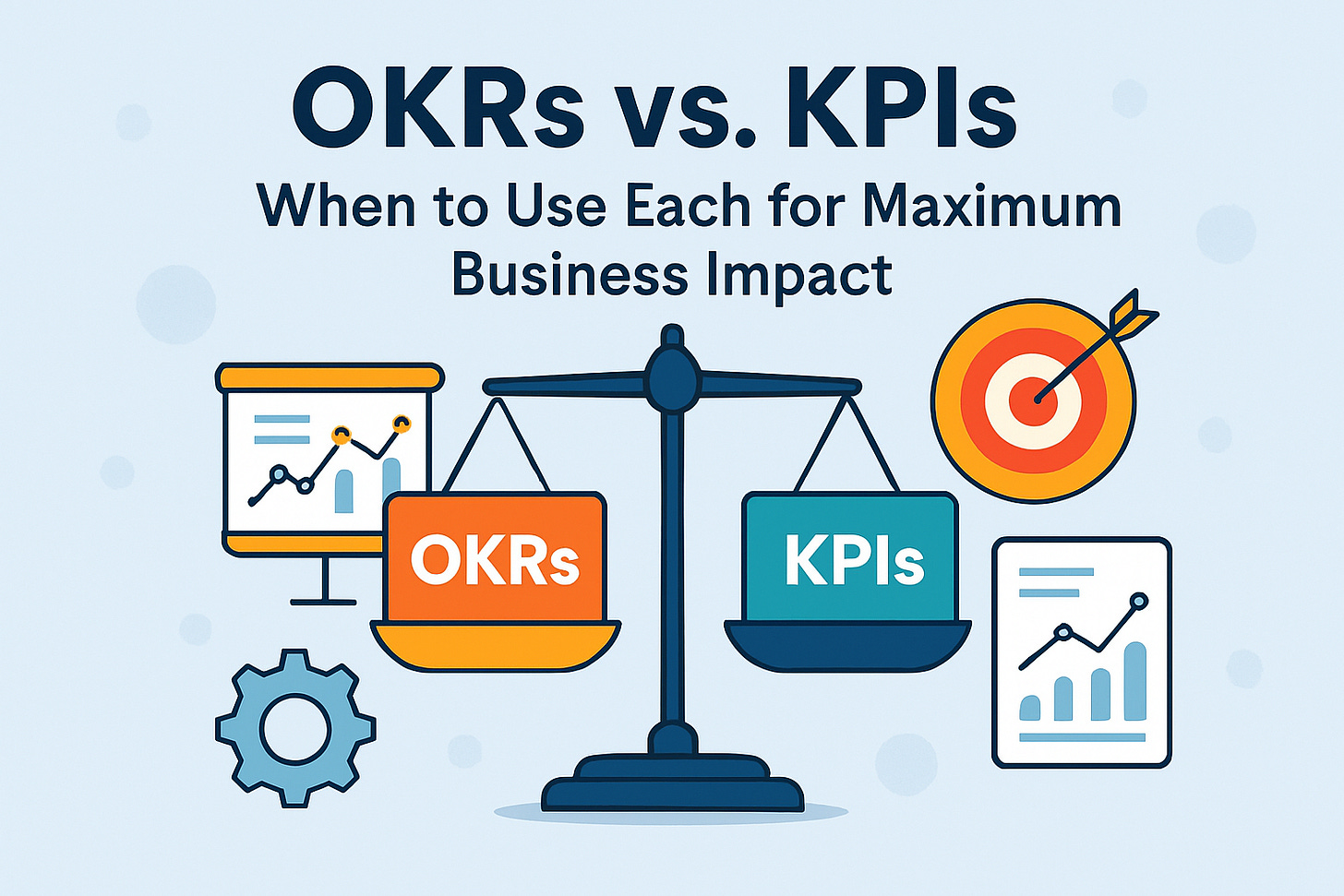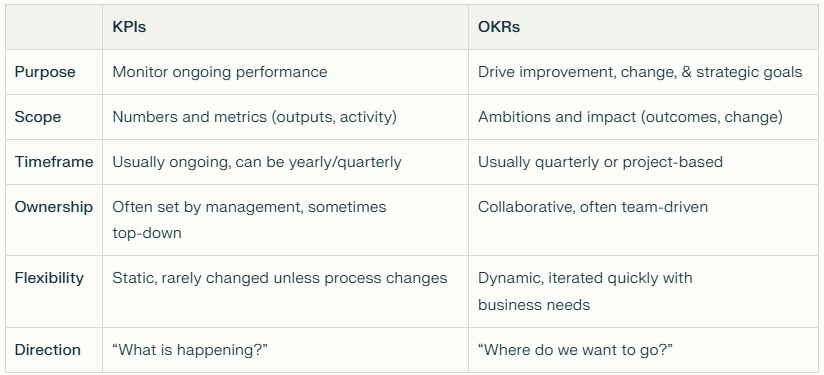OKRs vs. KPIs: When to Use Each for Maximum Business Impact
Confused about whether to focus on OKRs or KPIs for your team or organization? This deep dive arms you with insider strategies to leverage each framework, avoid common pitfalls, and drive outcomes—not
In modern businesses, measurement is everywhere. Teams, departments, and whole enterprises are constantly asked to prove their value and track progress. Two frameworks dominate this landscape:
OKRs (Objectives and Key Results) and KPIs (Key Performance Indicators).
Understanding when and how to use each isn’t just “nice to know”—it’s actually mission-critical for delivering results and avoiding the trap of vanity metrics.
Let’s explore their differences, practical applications, and strategic nuances so you can decide, for any goal, when an OKR beats a KPI, and vice versa.
What Are OKRs and KPIs?
KPIs are standalone metrics that measure how well a business process, team, or initiative is performing. Examples include:
Revenue Growth Rate
Support Ticket Resolution Time
Website Conversion Rate
KPIs serve as the “vital signs” of the business, indicating ongoing health and operational effectiveness. They are retrospective, providing snapshots of performance against static benchmarks.
OKRs, on the other hand, are a goal-setting methodology combining qualitative objectives with quantitative key results. Example:
Objective: Improve customer satisfaction
Key Result 1: Raise Net Promoter Score by 10 points
Key Result 2: Cut average ticket resolution time from 24h to 12h
OKRs drive change and improvement by aligning teams on what matters and describing how to measure progress toward stretching ambitions.
The Core Differences: Purpose and Use
KPIs keep the ship on course; OKRs set new courses, charting the journey to bold destinations.
Practical Situations: When to Use KPIs
Routine Tracking: For core business processes that don’t change much—think uptime, costs, customer retention—you need to know if operations are healthy.
Compliance/Regulation: Many industries require monitoring specific stats (e.g., financial ratios, safety incidents).
Ongoing Accountability: KPIs are the backbone of quarterly business reviews and dashboards that prove steady performance.
Benchmarking: Comparing against industry competitors or historical internal data.
Example:
A support team tracks average ticket closure time and customer satisfaction scores each month. These KPIs reveal whether the current processes deliver at or above expectations, and signal red flags if numbers slip.
Practical Situations: When to Use OKRs
Driving Transformation: Use OKRs to mobilize teams for major change—a new product launch, entering a new market, digital overhaul, or culture shift.
Strategic Alignment: OKRs align cross-functional teams, breaking silos for complex objectives.
Ambitious Goals: When you need to push beyond incremental improvements (“10x” goals, innovation leaps).
Learning and Adaptation: OKRs encourage rapid learning cycles; if a key result isn’t met, teams reflect and adapt.
Example:
A product management group sets an OKR:
“Become #1 in user satisfaction among competitors,” with key results targeting increased product review scores, improved onboarding, and reduced negative feedback.
This unites teams in coordinated change tied to a mission.
How Do OKRs and KPIs Interact?
The best organizations don’t choose one—they integrate both. Here’s how:
OKRs provide the “why” and “how” for improvement; KPIs track whether the underlying business remains healthy while chasing ambitious goals.
Often, Key Results in OKRs use existing KPIs as evidence. For instance, “Raise monthly active users (KPI) to 5,000” as a key result for “Expand product adoption.”
Use KPIs to monitor the status quo and OKRs to change it. When a KPI warning light wiggles, spawn an OKR to fix root causes. When you want breakthrough performance (not just steady outputs), OKRs are the engine.
Common Mistakes and How to Avoid Them
Using KPIs as a Proxy for Progress
It’s tempting to add more KPIs and call that “ambition.” But too many metrics dilute focus. If your KPIs aren’t tied to strategic objectives, teams chase numbers not purpose.
Setting OKRs That Read Like KPIs
Poorly designed OKRs simply restate KPIs (“increase sales by 5%”) without linking to a genuine objective (“Expand into new markets” OR “Reimagine customer buying experience”).
Failing to Track Ownership
KPIs can be remote (“Marketing sets it, Sales tracks it”), resulting in blurred accountability. OKRs, when set collaboratively, clarify who owns the goal and drives outcomes.
Static OKRs
OKRs should be dynamic—regularly reviewed, updated, even scrapped if priorities shift. Treating them as permanent targets undermines agility.
Real-Life Comparative Case Study
Imagine a SaaS company with a KPI: “80% of users renew their subscriptions annually.” The KPI tracks performance but doesn’t clarify how to increase renewals if slippage occurs.
Now, set an OKR:
Objective: Boost customer retention by delighting users
KR1: Launch 2 new highly-requested features by Q2
KR2: Achieve CSAT of 4.8+ on new features
KR3: Reduce support request volume for new features by 30%
Here, the Key Results quantify progress toward a purposeful objective—tied directly to boosting the renewal KPI.
How to Transition Between OKRs and KPIs
When KPIs Lag: If core performance slips, spin an OKR to address root causes.
For New Initiatives: Start with an OKR, track progress with KPIs for supporting metrics.
Quarterly Reviews: Use KPIs to review historical performance; use OKRs to set next-quarter priorities and transformation goals.
Combining Both: Insider Tips
Build dashboards showing both KPIs (ongoing health) and OKRs (change initiatives).
Review KPIs weekly/monthly for stability; OKRs for strategic progress quarterly.
Use KPIs as Key Results where relevant within OKRs for measurable ambitions.
Encourage teams to propose OKRs when KPIs are plateauing, not just lagging.
Celebrate when OKRs move KPIs in the right direction—close the loop.
Conclusion: Strategic Use Drives Value
OKRs and KPIs aren’t rivals; they’re complementary tools. KPIs monitor the “heartbeat” of your organization; OKRs rewired it for greatness.
Use KPIs when stability matters, compliance requires, or benchmarks inform.
Use OKRs to catalyze transformation, align multiple teams, and drive lasting change.
Mastering when to use each—and how to blend both—transforms measurement from a chore to a lever of business success.
The real art isn’t choosing one, but deploying both dynamically for continuous improvement.
Final Takeaway:
For ambitious organizations, KPIs ensure you never lose sight of business health, while OKRs propel you forward—building a culture of growth, innovation, and impact that endures
If you'd like templates, dashboards, or case studies on integrating both frameworks for your business, let me know!
If you liked this deep dive,
👉 Like, share, and restack it.
If this piece made you pause, reflect, or even jot something down for later, that’s the kind of work I love creating. Consider subscribing and joining my newsletter The Data Cell to get more of it straight to you.
You can also support my writing through Buy Me a Coffee — only if you want to and can.
And if you’d like to keep the conversation going, you’ll always find me on LinkedIn or X.
Thank you for reading :)



